Guide to bento packing and gap fillers
When I first started studying Japanese-language bento cookbooks, I was surprised to find that there are guidelines for how to physically pack a traditional bento lunch. This is separate from bento arrangement aesthetics or the 3:1:2 “Spinning Top” nutritional guidelines put out by the Japanese government (3 parts grains, 1 part protein, 2 parts vegetables). Like any guidelines, though, I think of them as interesting reference points (not rules!), and feel free to pack our lunches however I like.
How to Pack a Bento Lunch
(detailed notes and gap fillers behind the cut)
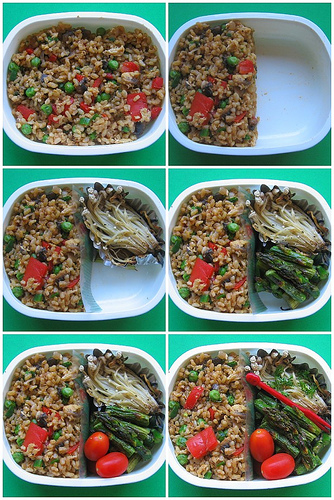
How to Pack a Bento
|
1) Spread Out Rice If packing warm rice, spread it in one layer across the bottom of the box for speedy cooling. This reduces condensation inside the box for better food safety and ease of opening. |
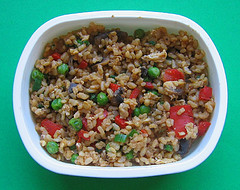 |
|
2) Pack Rice When cool, push the rice over to one side of the box. In a traditional bento meal, this would take up one half of the box. |
 |
| 3) Pack Main Dish Pack the main dish or bulky food that can’t change shape to fit the container (i.e. piece of fried chicken, long shrimp, etc.). This traditionally comprises one quarter of the meal. Dividers (plastic or edible) or food cups (disposable or reusable) are often used to keep food flavors from mingling. |
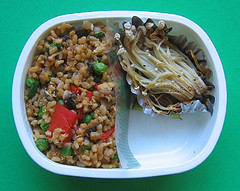 |
| 4) Pack Side Dishes ln the remaining space, pack side dishes or food that can be arranged flexibly to fill the available space (i.e. small pieces of vegetable). There are traditionally two sides, comprising the remaining quarter of the meal. |
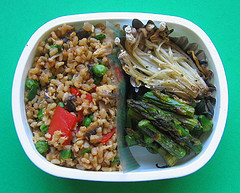 |
| 5) Plug the Gaps If there is any empty space in the bento box, plug those gaps with small, non-fragile food items. See examples of gap fillers below. |
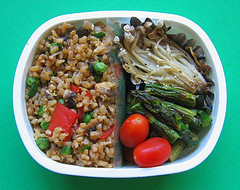 |
| 6) Garnish, Accessorize Add any garnishes, decorations (furikake sprinkles, surprise animal cap, or cutouts of nori, vegetables, cheese or meat, etc.), sauce containers or picks for easy eating. Allow the lunch to cool sufficiently before closing the lid. |
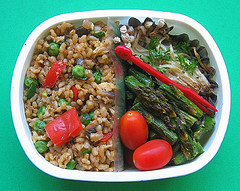 |
(Details on the contents of the lunch pictured above are here.)
Don’t Leave Empty Space!
You can spend a long time creating a beautiful, intricately decorated bento, but if you don’t pack things tightly the contents are likely to shift in transport and ruin your efforts. The list of potential foods that are well suited to fill small gaps in your bento box is endless, but they should be small, sturdy (avoid fragile items such as raspberries), and unlikely to transfer flavors to neighboring foods. (Click links to see sample lunches.)
- Cherry tomatoes (also great for a splash of color, as above)
- Wrapped cheeses (cubes, triangles, round Babybel)
- Pickles (Western or Asian)
- Dried fruit or nuts
- Small, whole fresh fruits (grapes, cherries, blueberries, strawberries, kumquats, small plums, etc.)
- Mini puddings or jellies (individually wrapped)
- Sauce containers
- Quail eggs (hard boiled and shelled, either shaped or plain)
What are your favorite gap fillers? Comment and let us know!
READ MORE:
- Bento FAQ
- How to care for your bento gear
- Need for speed: A mommy’s lunch manifesto
- Choosing the right size bento box
- Packed lunch food safety
- Biggie’s list of top speed tips, tutorials and equipment reviews
- Subscribe to Lunch in a Box by e-mail updates or via RSS feed





